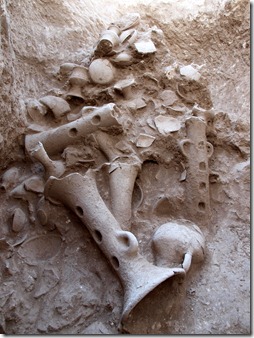Objects from a 13th-century BC cultic pit discovered in 2010 near Jokneam go on display this week at Haifa’s National Maritime Museum. More than 200 items were found in a favissa near Tel Qashish during construction of a pipeline. From the Jerusalem Post:
The treasure trove contains pottery vessels from the Late Canaanite Age IIB (1300-1200 BCE), which were stored in an elliptical pit of limestone rock – 3 meters high by 1.5 meters wide by 3 meters deep – containing more than 200 items, mostly previously unknown and quite rare, according to a statement from the exhibition. Inside the pit were items made locally, in Mycenae and in Cyprus. The locally-made products presumably for cult use included goblets – one with a man’s face sculpted on it – tall cylindrical stands, small stands, incense burners and chalices for libation, burning oil and incense. According to the exhibition, they indicate that the trove belonged to a local temple that has not yet been discovered and were items brought by worshipers. However, researchers have neither been able to identify the specific deity nor the worshipers themselves. “The pottery was either buried in haste for fear of damage by enemy forces, or stored in the pit when there was no more room elsewhere, or discarded,” the statement from the exhibition said. Among other more common local items were bowls, jugs, juglets, cooking pots, oil lamps, Canaanite jars and cup-andsaucer sets. From Cyprus, the favissa contained bowls of white-slip and base-ring wares, as well as white-shaved juglets.
The full story is here. We noted the original discovery in June 2010. The IAA press release includes a few photos and six high-resolution images are available here. The original audio slideshow is still available at Discovery News. HT: Joseph Lauer  Cultic objects at time of discovery.
Cultic objects at time of discovery.
Photo by Assaf Peretz, courtesy of the Israel Antiquities Authority.